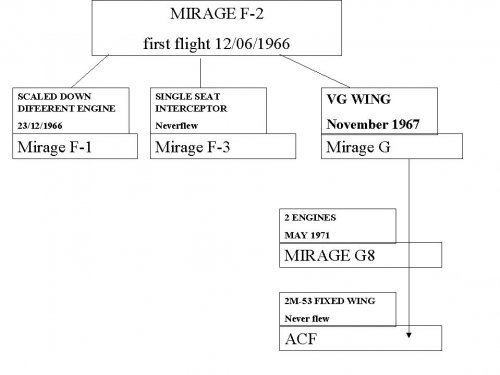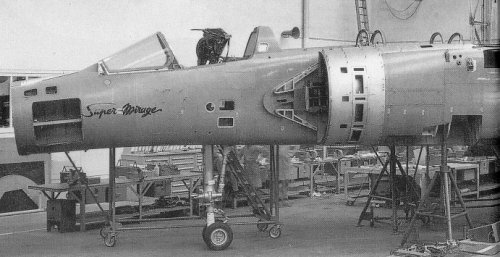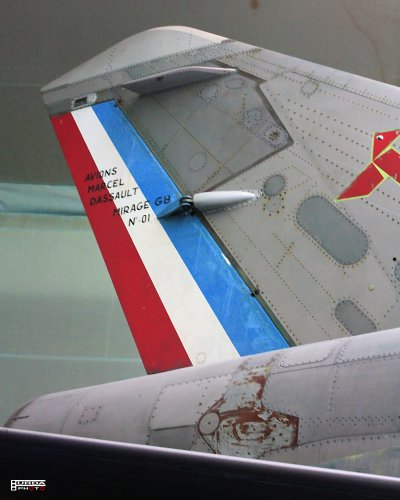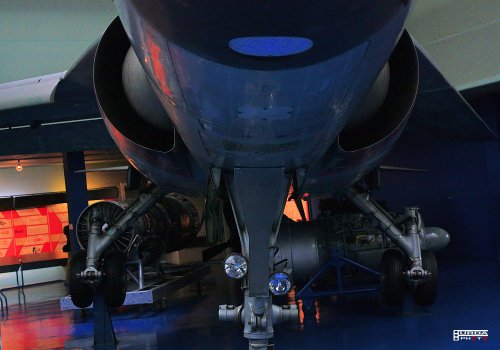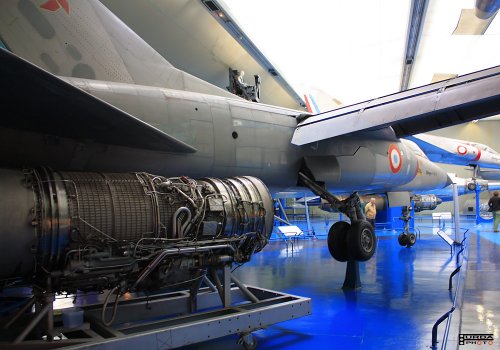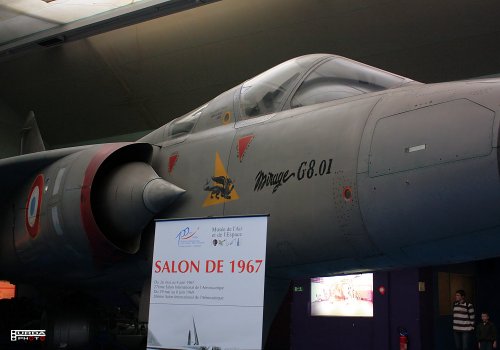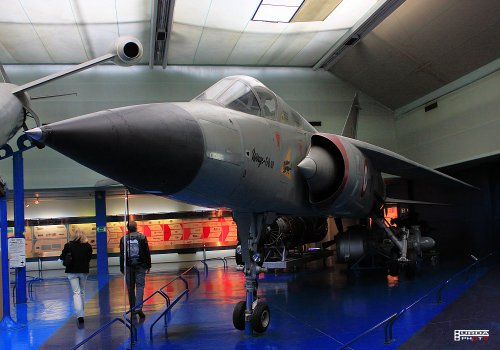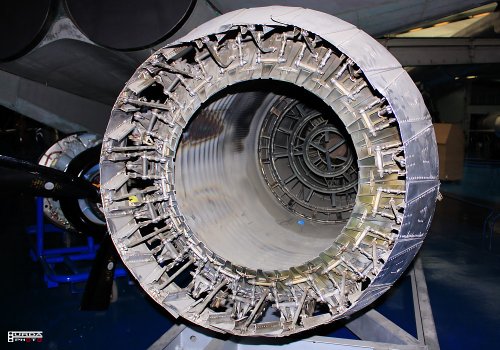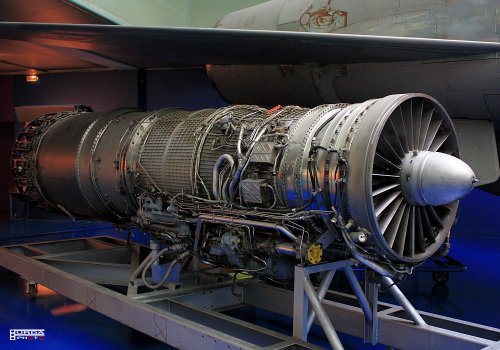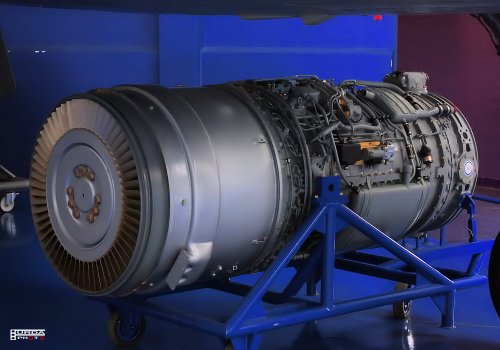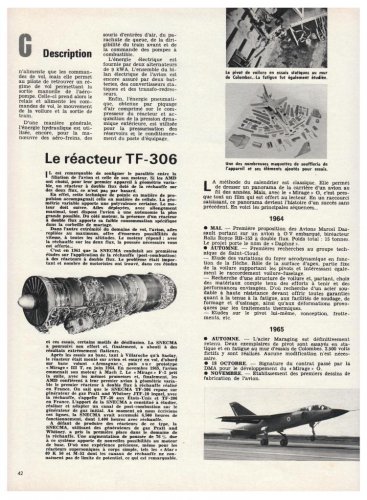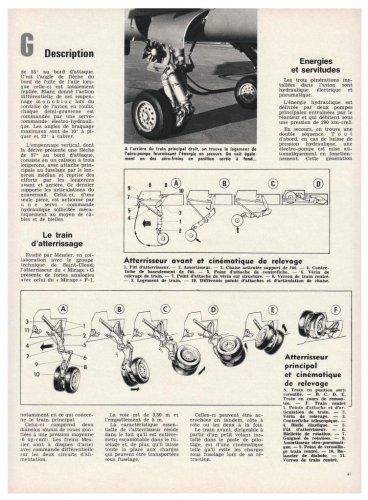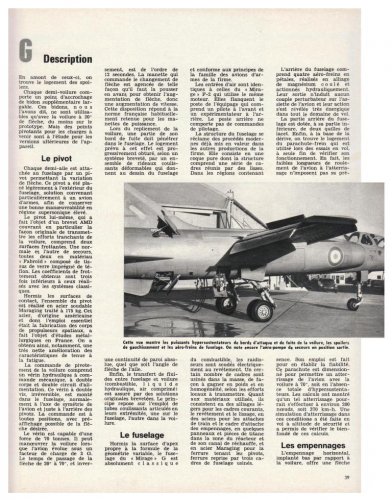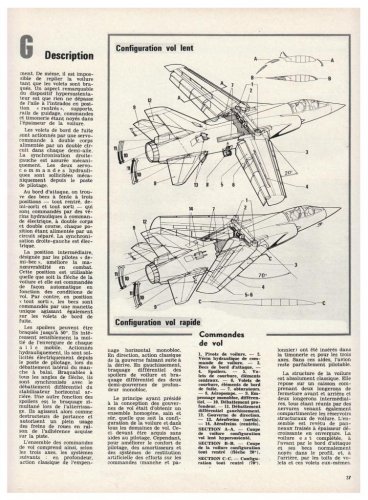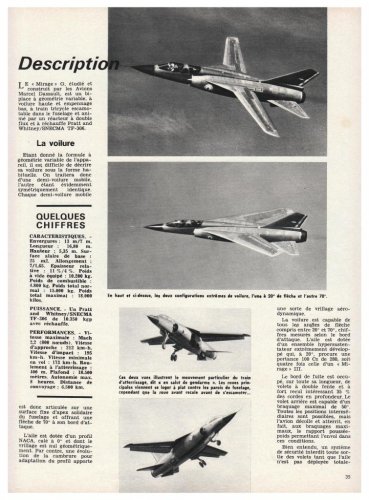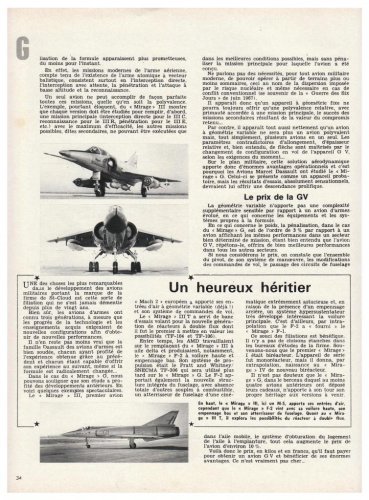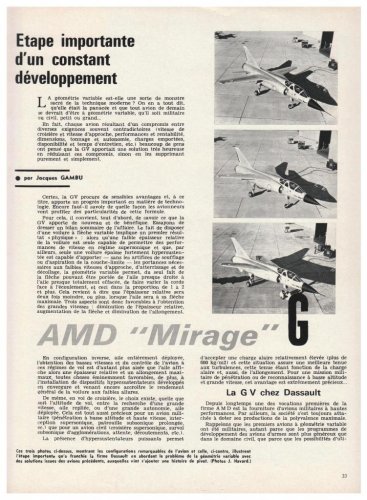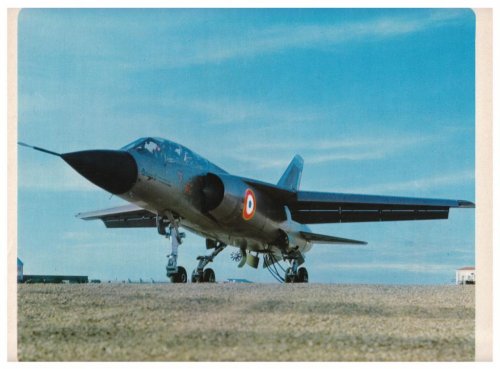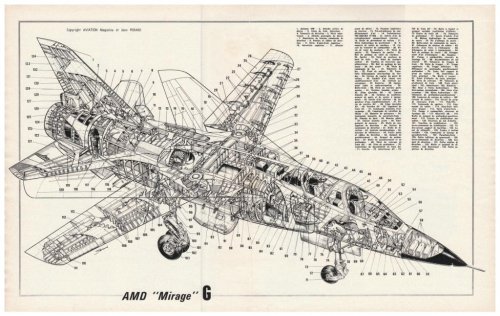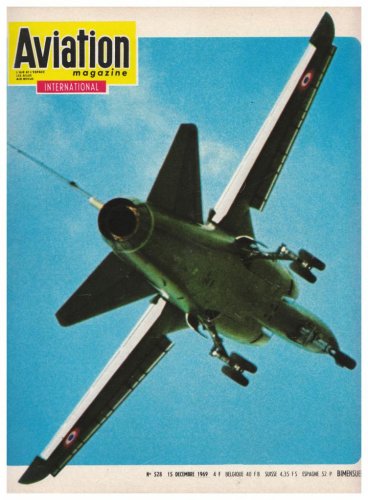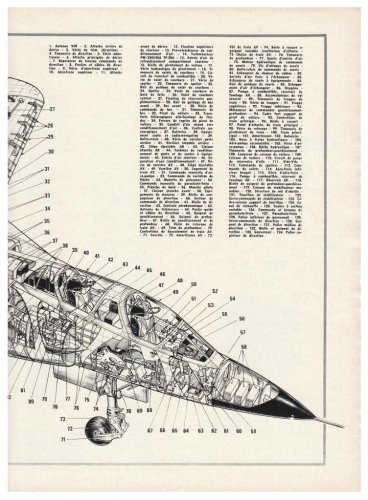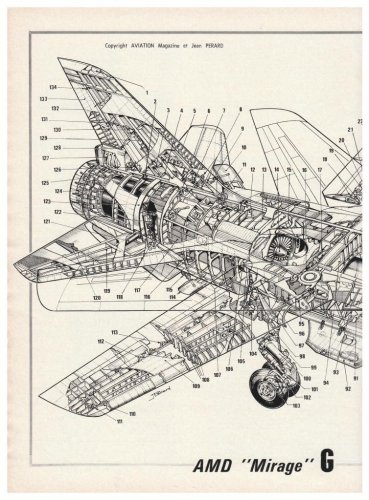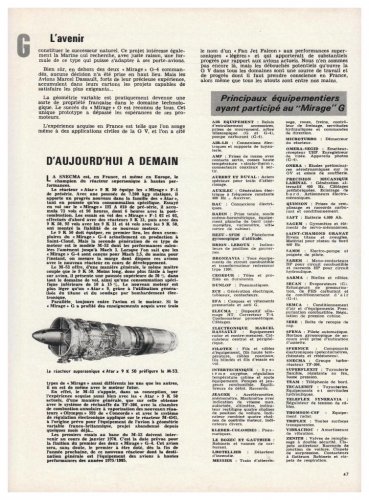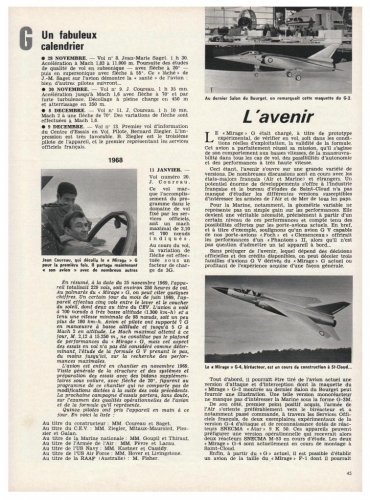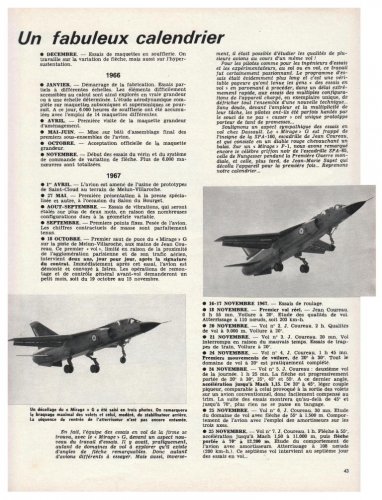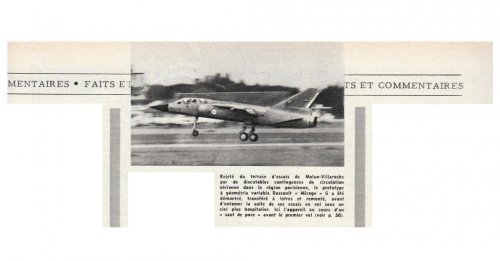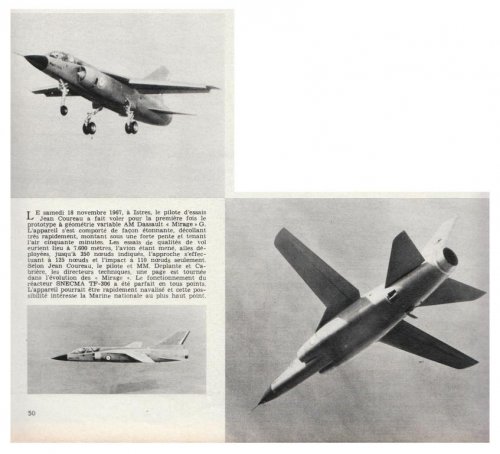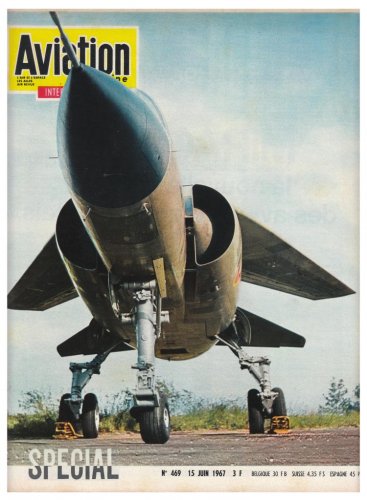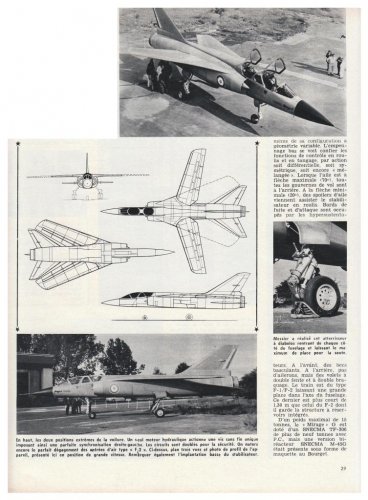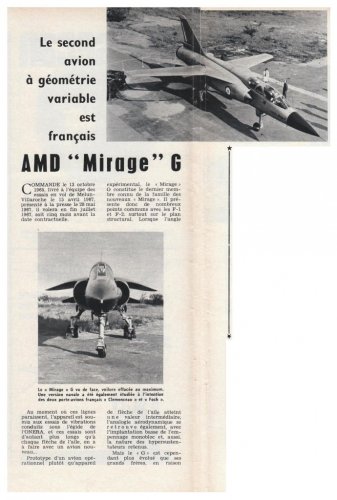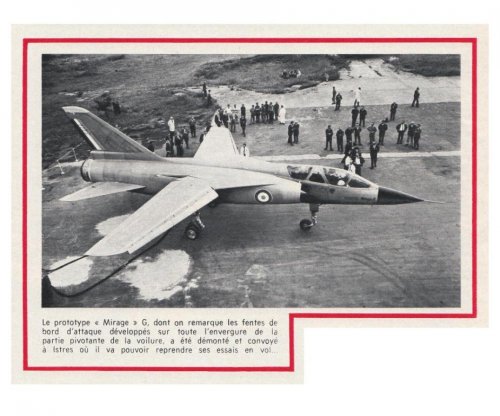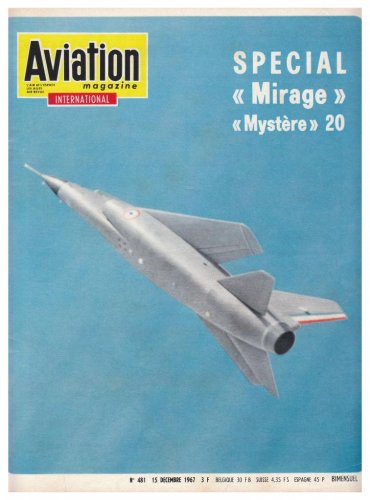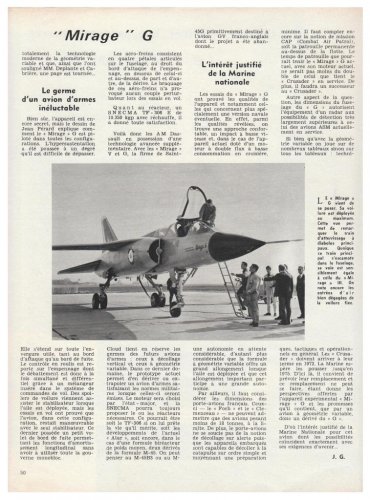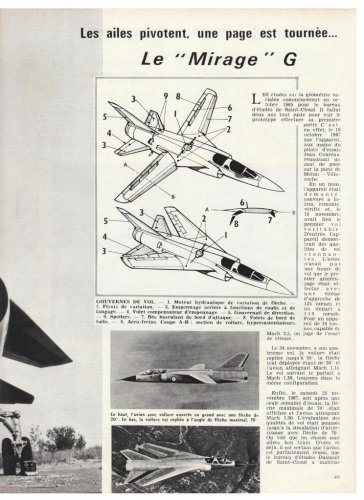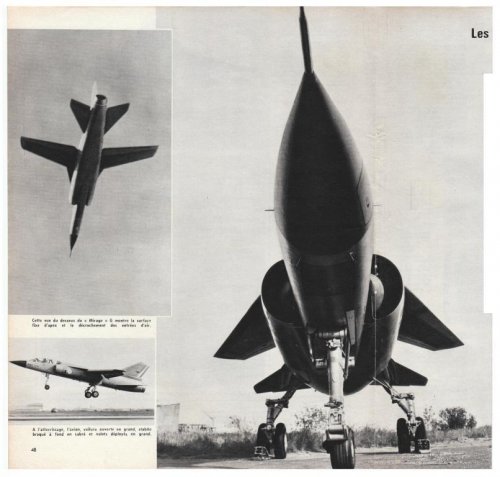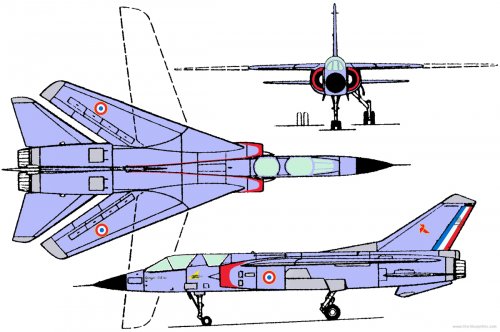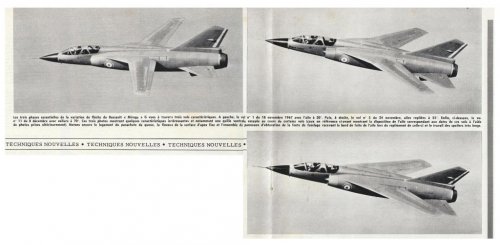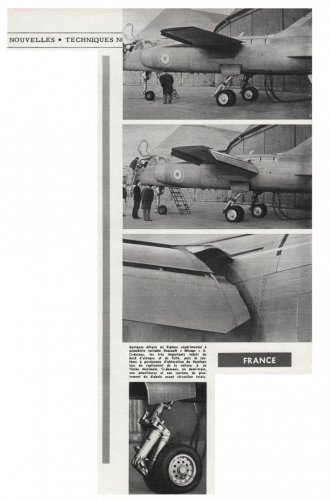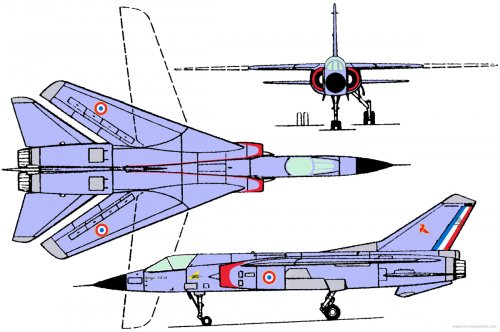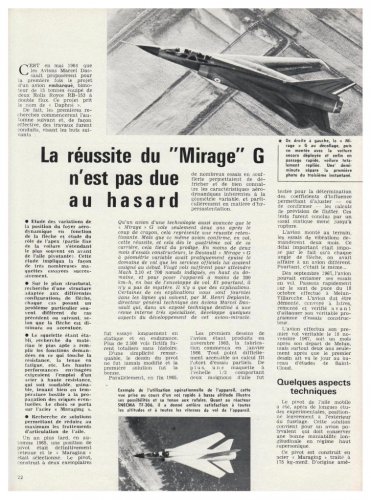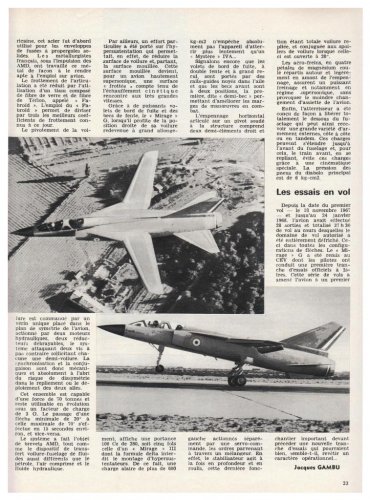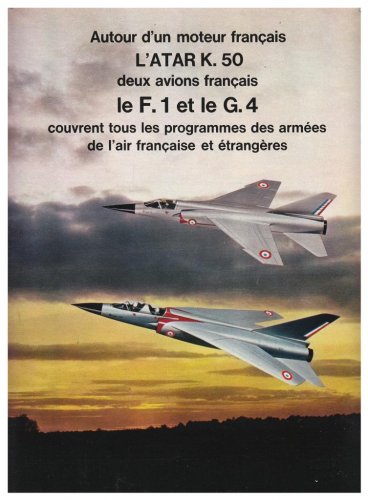All this projects were developed at the same time (1965-1967) and in paralel. I have difficulties understanding the exact role of the AFVG for France (interceptor ? long range strike to replace the Mirage IV ? )
Variable geometry Mirages
(Henry Matthews)
The Variable Geometry Mirages
Mirage G
The first proposals from Dassault concerning a carrier-borne variable geometry aircraft, designated Mirage GV (géometrie variable) then simply Mirage G were made in May 1964, with research work being carried out by a team at Dassault's St. Cloud factory. The design was finalized in 1965 and on 13 October that year, Dassault was awarded a contract to build a single Mirage G prototype. The very first construction drawings began in November 1965, and from January 1966, production work proceeded concurrently with tests on full-scale and reduced scale sub-assemblies. An engineering mockup was inspected in November 1966. The aircraft was completed in spring 1967 and was taken to the Melun-Villaroche airfield for vibration testing.
The Mirage G was revealed to the press at Melun-Villaroche on 3 June 1967. It was powered by a single Pratt and Whitney/SNECMA TF 106E engine producing 9,300 kg of thrust. It carried no armament.
On 18 October 1967, Dassault Test Pilot Jean Coureau made the first hop, with wings maintained in the extended position. The aircraft was then dismantled and trucked to the flight test center at Istres, where it made its first official test flight on 18 November 1967, again with Coureau at the controls. The flight lasted 50 min, and was made with a fixed wingsweep of 25° to an altitude of 10,000 m. The aircraft approach speed was 232 kmph and landing speed was 205 kmph.
The prototype demonstrated its swing wing ability in the first week of flying. On 24 November 1967, during the 4th flight and with Coureau at the controls, wing sweep was changed to 55°. During Fight 7, on 25 November, the aircraft flew to Mach 1.5, with a maximum sweep of 70°. That same day Coureau was named Dassault Chief Test Pilot.
On 28 November 1967 during Flight 8, the Mirage G reached a speed of Mach 1.83 at 35,400 ft. Flown by Jean-Marie Saget, the objectives of this sortie were to study flight characteristics at both subsonic and supersonic speeds, with wing sweep angles of 20°, 55° and 66°.
During Flight 11, on 8 December 1967, Coureau achieved Mach 2. Flight 12, on 9 December 1967, was the first CEV flight and was made by Major Bernard Ziegler. The Mirage G was demonstrated to the press during its flight 17, with Coureau at the controls, on 20 December 1967.
By late December, less than two months after its first flight, the Mirage G had logged 20 flights within a speed envelope of Mach 2.1, which was the limit fixed by the authorities for the first test series. On 18 January 1968, exactly two months after its first official flight, the Mirage G made its Flight 25. By 24 January, the aircraft had completed 28 flights, totalling 37 hr 30 min.
This first series of flights confirmed the remarkable qualities of this aircraft, especially at low speeds (approach at 125 knots, touch-down at 108-110 knots) and the ease of operation of the wings under g loading. Virtually the whole speed range from 110 knots to Mach 2 had been investigated at high and low altitude.
By the end of its first year of operations, the aircraft's log stood at 100 flights in 112 hours, made by Coureau, Saget, Ziegler and the CEAM's Lt Col Favre.
A four-flight evaluation of the Mirage G as a prototype, variable geometry, fighter airplane was made at Istres during the period 4-10 November 1968 by US Navy test pilots Tom M. Kastner (3 flights) and Tom Kassidy (one flight) and they reported that it had excellent performance and outstanding flying qualities.
During the following months, the aircraft acquired the improved TF-306 E engine (10,330 kg of thrust) to allow further envelope expansion beyond the agreed specifications. By mid 1969, the aircraft had logged 150 flights.
In July 1969, USAF test pilots Major Hoever and Major Levington made another four-flight evaluation of the aircraft.
In September, RAAF Squadron Leader Fisher made another four-flight evaluation. His first flight was the aircraft's 200th flight.
In October 1969, the aircraft was officially taken in charge by the CEV.
By year's end, the speed envelope had been extended to 700 kt at sea level, piloting systems had been improved and 70 flights had been made with external stores, in view of an operational variant of the aircraft.
Unfortunately the Mirage G crashed on 13 January 1971 while piloted by Jean Coureau, during Flight 316, after take-off from Istres. Coureau ejected safely but the aircraft was destroyed. It had logged some 400 flying hours and paved the way for the Mirage G4/G8 design.
The French Navy had considered the Mirage G for production and deemed it suitable for carrier operations. However it had its mind set on the Jaguar M (Marine) which itself was eventually denied production. Changes in official policies lead to the dropping of plans to produce the American TF 30 under license in France. This would have powered some of the operational versions planned of the Mirage G.
Mirage G Data
Length: 16.8 m
Wing span: 14 m (max), 7.3 m (minimum)
Weight: 10 tons empty, 17 tons fully fueled
Mirage G.8
Derived from the Mirage G, the Mirage G4 and Mirage F1 were proposed by Dassault on 6 June 1967 to replace a still-born Franco-British variable geometry program (British ASR 388, Specification 260). The Mirage F1 was an interceptor and the Mirage G4 was for strike and long range reconnaissance. On 2 October 1967, the Air Staff issued a requirement for a long range reconnaissance and strike aircraft under the name RAGEL (Reconaissance, Attaque, Guerre Electronique Lointaine) and the Mirage G4 was chosen to meet it.
As finalized, the Mirage G4 was a twin-engined variable geometry aircraft, with capability for hi-lo-hi, short take-off and landing. Sweep angle varied between 23° and 70° like the Mirage G and maximum speed was set to be higher than Mach 2. Range was 3,000 km. Armament consisted of two AA missiles and two guns (optional) and the aircraft was to be equipped with a vertical panoramic camera and a radar in the nose. The engines were the SNECMA 9k50, rated each at 7,200 kg of thrust, mounted side-by-side and fed from integral fuel tanks in the fuselage.
The Mirage G4 was a bi-seater, of entirely metallic monocoque construction, with high lift devices such as leading and trailing edge flaps. It had a swept rudder and both horizontal stabilizers were differentially controlled. As typical of Mirage designs, the side air intakes were fitted with moving shock cones.
Two Mirage G4 prototypes were ordered on 6 September 1968. Construction of Mirage G4 001 began late in 1968. However, shortly after becoming French Air Force Chief-of-Staff, General Gauthier asked Dassault to shelve the Mirage G4 for replacement by a lighter, more maneuverable aircraft. The Mirage G4 metamorphosed into the Mirage G8, which was 1.10 m shorter. The aircraft now took an additional role of high and low altitude interception, and the SNECMA 9K50 engines were replaced with SNECMA M53s of 8,500 kg thrust each. The first Mirage G8 (former G4) was a twin-seater and the second was a single-seater.
Mirage G8 001 was first flown on Saturday 8 May 1971, with Dassault test pilot Jean-Marie Saget at the controls and with the second seat empty, taking off with the afterburner on. The aircraft climbed to 30,000 ft and maneuvers were made at Mach .73 with the wings kept in a fixed position. During the second flight on 11 May the first sweep change was made to 55° and Mach 1.25 was achieved. During Flight 3 on 12 May, the wings were completely swept to 70° and Mach 1.6 was achieved. During Flight 4 on 13 May, sweep was again changed to 70° and Saget demonstrated that he could climb the aircraft on the power of one engine only to 26,000 ft.
With Saget at the controls, the aircraft was flown at the Paris Air Show of 1971 and thrilled spectators with its moving wings and dramatic profile.
Flight 8, the first CEV flight, was made by Major Galan for familiarization purposes. Flight 11 was a demonstration to the French President of the Republic.
Despite the aircraft's weak thrust-to-weight ratio which was .6, Saget demonstrated that it could climb to 50,000 ft and Mach 2.1 in 5 min after roll start. Ceiling was 57,000 ft. For landing and takeoff, speed was 125 kt and distance was 500 m.
From early November to early December 1971, the aircraft was flown in a new test phase, and it made 39 flights covering 50 hr in a program aimed at obtaining precise analyses of flight characteristics in all configurations. Some flights were made at speeds in excess of Mach 2 and 40,000 ft (12 km). Landing impact point speed was 116 kts.
Mirage G8 001 had logged 150 hours when it was moved to the CEV at Istres on 5 October 1972. It finished its test programme in July 1973 and was put into storage after 220 flights covering 22l hr. The maximum speed achieved was Mach 2.2, or 750 kt IAS, at 65,000 ft.
Mirage G8 002 was first flown on 13 July 1972. A year later, on 13 July 1973, fitted with stores pylons for the planned underwing weapons, this aircraft achieved Mach 2.34 at 49,000 ft during routine afterburner tests, with Saget at the controls. This was the highest speed attained by a West European aircraft, and the flight was followed by a series of prolonged high-Mach thermal tests which made up part of Mirage G8 002's program. The aircraft was also involved in pivot load tests, air-to-air refueling trials and a study of the possibility of modifying the jetpipe for sustained high-Mach flight.
G8 002's last flights were made with the wings in a fixed position at 55°. The aircraft was last flown on 22 November 1974. It was Flight 127.
The total number of Mirage G8 flights (both aircraft) was 347.
The Mirage G8 never went into production mainly because it was considered too expensive.
A Mirage G8A fixed wing project, with a 55° sweep angle and the same SNECMA M53 engines, was studied in 1973-1975 but it remained paper-bound. (Ie the ACF)

